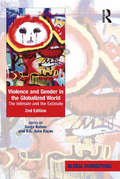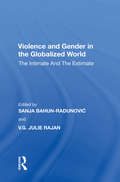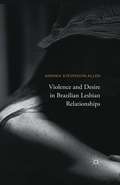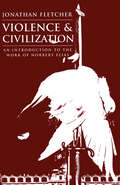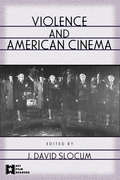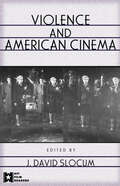- Table View
- List View
Violence and Gender in the Globalized World: The Intimate and the Extimate (Global Connections)
by Sanja Bahun V.G. Julie RajanViolence and Gender in the Globalized World expands the critical picture of gender and violence in the age of globalization by introducing a variety of uncommonly discussed geo-political sites and dynamics. The volume hosts methodologically and disciplinarily diverse contributions from around the world, discussing various contexts including Chechnya, Germany, Iraq, Kenya, Malaysia, Nicaragua, Palestine, the former Yugoslavia, Syria, South Africa, the United States, and the Internet. Bringing together scholars’ and activists’ historicized and site-specific perspectives, this book bridges the gap between theory and practice concerning violence, gender, and agency. In this revised and updated edition, the scope of inquiry is expanded to incorporate phenomena that have recently come to the forefront of public and scholarly scrutiny, such as Internet-based discourses of violence, female suicide bombers, and the Islamic State’s violence against women. At the same time, new data and developments are brought to bear on earlier discussions of violence against women across the globe in order to bring them fully up to date. With an international team of contributors, comprising eminent scholars, activists and policy-makers, this volume will be of interest to anyone conducting research in the areas of gender and sexuality, human rights, cultural studies, law, sociology, political science, history, post-colonialism and colonialism, anthropology, philosophy and religion.
Violence and Gender in the Globalized World: The Intimate and the Extimate (Global Connections)
by Sanja Bahun V.G. Julie RajanViolence and Gender in the Globalized World expands the critical picture of gender and violence in the age of globalization by introducing a variety of uncommonly discussed geo-political sites and dynamics. The volume hosts methodologically and disciplinarily diverse contributions from around the world, discussing various contexts including Chechnya, Germany, Iraq, Kenya, Malaysia, Nicaragua, Palestine, the former Yugoslavia, Syria, South Africa, the United States, and the Internet. Bringing together scholars’ and activists’ historicized and site-specific perspectives, this book bridges the gap between theory and practice concerning violence, gender, and agency. In this revised and updated edition, the scope of inquiry is expanded to incorporate phenomena that have recently come to the forefront of public and scholarly scrutiny, such as Internet-based discourses of violence, female suicide bombers, and the Islamic State’s violence against women. At the same time, new data and developments are brought to bear on earlier discussions of violence against women across the globe in order to bring them fully up to date. With an international team of contributors, comprising eminent scholars, activists and policy-makers, this volume will be of interest to anyone conducting research in the areas of gender and sexuality, human rights, cultural studies, law, sociology, political science, history, post-colonialism and colonialism, anthropology, philosophy and religion.
Violence and Gender in the Globalized World: The Intimate and the Extimate (Global Connections Ser.)
by Sanja Bahun-Radunović V. G. Julie RajanViolence and Gender in the Globalized World expands the present discourse on gender and violence, discovering new ways to address the complexities encountered in academic research on the topic. Through the introduction of a variety of uncommonly discussed geopolitical sites and dynamics, the book redefines the critical picture of gender violence in the age of globalization, adopting diverse methodological approaches and various disciplinary praxes in its investigation of the question of violence against women across the globe. With an international team of contributors comprising both scholars and activists, this volume bridges the gap between academic and activist perspectives on gender violence. As such, it will be of interest to anyone conducting research in the areas of gender and sexuality, human rights, cultural studies, political science, history, postcolonialism and colonialism, sociology, anthropology, philosophy and religion.
Violence and Gender in the Globalized World: The Intimate and the Extimate
by Sanja Bahun-RadunovicViolence and Gender in the Globalized World expands the present discourse on gender and violence, discovering new ways to address the complexities encountered in academic research on the topic. Through the introduction of a variety of uncommonly discussed geopolitical sites and dynamics, the book redefines the critical picture of gender violence in the age of globalization, adopting diverse methodological approaches and various disciplinary praxes in its investigation of the question of violence against women across the globe. With an international team of contributors comprising both scholars and activists, this volume bridges the gap between academic and activist perspectives on gender violence. As such, it will be of interest to anyone conducting research in the areas of gender and sexuality, human rights, cultural studies, political science, history, postcolonialism and colonialism, sociology, anthropology, philosophy and religion.
Violence and Gender in Ancient Egypt (Archaeology of Gender and Sexuality)
by Uroš MatićViolence and Gender in Ancient Egypt shifts the focus of gender studies in Egyptology to social phenomena rarely addressed through the lens of gender – war and violence, exploring the complex intersections of violence and gender in ancient Egypt. Building on current discussions in philosophy, anthropology, and sociology, and on analysis of relevant historic texts, iconography, and archaeological remains by looking at possible gender patterns behind evidence of trauma, the book bridges the gap between modern understandings of gendered violence and its functioning in ancient Egypt. Areas explored include the following: differences in gendered aggression and violent acts between people and deities; sexual violence; the taking of men, women, and children as prisoners of war; and feminization of enemies. By examining ancient Egyptian texts and images with evidence for violence from different periods and contexts – private tombs, divine temples, royal stelae, papyri, and ostraca, ranging over 3,000 years of cultural history – Violence and Gender in Ancient Egypt highlights the complex intersection between gender and violence in ancient Egyptian culture. The book will appeal to scholars and students working in Egyptology, archaeology, history, anthropology, sociology, and gender studies.
Violence and Gender in Ancient Egypt (Archaeology of Gender and Sexuality)
by Uroš MatićViolence and Gender in Ancient Egypt shifts the focus of gender studies in Egyptology to social phenomena rarely addressed through the lens of gender – war and violence, exploring the complex intersections of violence and gender in ancient Egypt. Building on current discussions in philosophy, anthropology, and sociology, and on analysis of relevant historic texts, iconography, and archaeological remains by looking at possible gender patterns behind evidence of trauma, the book bridges the gap between modern understandings of gendered violence and its functioning in ancient Egypt. Areas explored include the following: differences in gendered aggression and violent acts between people and deities; sexual violence; the taking of men, women, and children as prisoners of war; and feminization of enemies. By examining ancient Egyptian texts and images with evidence for violence from different periods and contexts – private tombs, divine temples, royal stelae, papyri, and ostraca, ranging over 3,000 years of cultural history – Violence and Gender in Ancient Egypt highlights the complex intersection between gender and violence in ancient Egyptian culture. The book will appeal to scholars and students working in Egyptology, archaeology, history, anthropology, sociology, and gender studies.
Violence and Gender in Africa's Iberian Colonies: Feminizing the Portuguese and Spanish Empire, 1950s–1970s (Cambridge Imperial and Post-Colonial Studies Series)
by Andreas StuckiThis book examines how and why Portugal and Spain increasingly engaged with women in their African colonies in the crucial period from the 1950s to the 1970s. It explores the rhetoric of benevolent Iberian colonialism, gendered Westernization, and development for African women as well as actual imperial practices – from forced resettlement to sexual exploitation to promoting domestic skills. Focusing on Angola, Mozambique, Western Sahara, and Equatorial Guinea, the author mines newly available and neglected documents, including sources from Portuguese and Spanish women’s organizations overseas. They offer insights into how African women perceived and responded to their assigned roles within an elite that was meant to preserve the empires and stabilize Afro-Iberian ties. The book also retraces parallels and differences between imperial strategies regarding women and the notions of African anticolonial movements about what women should contribute to the struggle for independence and the creation of new nation-states.
Violence and Emotions in Early Modern Europe
by Susan Broomhall Sarah FinnViolence and Emotions in Early Modern Europe examines the purposes for which specific forms of violence and particular emotional states functioned, how they operated in relation to each other, or indeed how one provoked, sustained or diminished the other. These twelve original essays demonstrate the complexities of violence and emotions and the myriad possibilities of their inter-relationships. They emphasize the great efforts that were made by early modern societies to control modes of violence and emotional regimes to achieve positive as well as negative effects, such as creating order, healing, and bringing individuals and communities together around productive identities. Authors consider legal documents, news reports, memoirs, letters, confraternity statutes, and medical consultations to investigate the bodily and textual practices in which violent and emotional acts were created, supported and disseminated to investigate the power, aims, effect and outcomes of relationships between violence and emotions. The chapters look at a range of topics and countries including Renaissance Italy and sixteenth-century Germany, France in the grip of the religious wars, and England’s Civil Wars as well as a wide range of topics including murder, punishment, community healing, insults, threats, prophecy and medical and devotional practices. This collection will be essential reading for students and scholars of the history of emotions or violence.
Violence and Emotions in Early Modern Europe
by Susan Broomhall Sarah FinnViolence and Emotions in Early Modern Europe examines the purposes for which specific forms of violence and particular emotional states functioned, how they operated in relation to each other, or indeed how one provoked, sustained or diminished the other. These twelve original essays demonstrate the complexities of violence and emotions and the myriad possibilities of their inter-relationships. They emphasize the great efforts that were made by early modern societies to control modes of violence and emotional regimes to achieve positive as well as negative effects, such as creating order, healing, and bringing individuals and communities together around productive identities. Authors consider legal documents, news reports, memoirs, letters, confraternity statutes, and medical consultations to investigate the bodily and textual practices in which violent and emotional acts were created, supported and disseminated to investigate the power, aims, effect and outcomes of relationships between violence and emotions. The chapters look at a range of topics and countries including Renaissance Italy and sixteenth-century Germany, France in the grip of the religious wars, and England’s Civil Wars as well as a wide range of topics including murder, punishment, community healing, insults, threats, prophecy and medical and devotional practices. This collection will be essential reading for students and scholars of the history of emotions or violence.
Violence and Desire in Brazilian Lesbian Relationships
by Andrea Stevenson AllenIn Violence and Desire in Brazilian Lesbian Relationships, Allen examines the lives of Brazilian women in same-sex relationships. This examination contributes to interdisciplinary discussions of female same-sex sexuality, violence, race, and citizenship. Using fifteen months of ethnographic fieldwork, primarily with Afro-Brazilian women in the city of Salvador da Bahia, Allen argues that Brazilian lesbian women reject Brazilian cultural norms that encourage male domination and female submission through their engagement in romantic relationships with each other. At the same time Allen claims lesbian women also reproduce Brazilian cultural ideals that associate passion, intensity, and power with physical dominance through their engagement in infidelity and intimate partner violence. The book demonstrates that lesbian women are nonetheless marginalized as Brazilian citizens through widespread social and political invisibility despite these apparent displays of masculinized power.
Violence And Democracy (PDF)
by John KeaneIn this provocative book, John Keane calls for a fresh understanding of the vexed relationship between democracy and violence. Taking issue with the common sense view that 'human nature' is violent, Keane shows why mature democracies do not wage war upon each other, and why they are unusually sensitive to violence. He argues that we need to think more discriminatingly about the origins of violence, its consequences, its uses and remedies. He probes the disputed meanings of the term violence, and asks why violence is the greatest enemy of democracy, and why today's global 'triangle of violence' is tempting politicians to invoke undemocratic emergency powers. Throughout, Keane gives prominence to ethical questions, such as the circumstances in which violence can be justified, and argues that violent behaviour and means of violence can and should be 'democratised' - made publicly accountable to others, so encouraging efforts to erase surplus violence from the world. 9780521836999
Violence and Crime in the Family: Patterns, Causes, and Consequences (Contemporary Perspectives in Family Research #9)
by Sampson Lee Blair Sheila Royo MaxwellIn virtually all societies, crime is an ever-present problem. Although families are often envisioned as a 'safe haven,' criminologists and family researchers have found the familial context to be at the core of many forms of crime and violence. Family members often find themselves as victims of crime and violence, often perpetrated by yet another family member. The unique nature of family relationships, such as those between children and parents, sometimes lead to intergenerational patterns of violence within families. Understandably, societies often struggle to address crime and violence within families; as such behaviors are often unreported and even concealed. Even beyond the family, crime and criminal behavior can often directly impact familial relationships, such as with the incarceration of a spouse or parent. This multidisciplinary volume of CPFR will address topics such as: child abuse and neglect, spousal violence, incarceration and parenting, community crime and family well-being, family life and delinquency, intrafamily violence, and policy-related issues pertaining to family violence.
Violence and Community: Law, Space and Identity in the Ancient Eastern Mediterranean World
by Kostas Vlassopoulos Ioannis K. Xydopoulos Eleni TountaViolence and community were intimately linked in the ancient world. While various aspects of violence have been long studied on their own (warfare, revolution, murder, theft, piracy), there has been little effort so far to study violence as a unified field and explore its role in community formation. This volume aims to construct such an agenda by exploring the historiography of the study of violence in antiquity, and highlighting a number of important paradoxes of ancient violence. It explores the forceful nexus between wealth, power and the passions by focusing on three major aspects that link violence and community: the attempts of communities to regulate and canalise violence through law, the constitutive role of violence in communal identities, and the ways in which communities dealt with violence in regards to private and public space, landscapes and territories. The contributions to this volume range widely in both time and space: temporally, they cover the full span from the archaic to the Roman imperial period, while spatially they extend from Athens and Sparta through Crete, Arcadia and Macedonia to Egypt and Israel.
Violence and Community: Law, Space and Identity in the Ancient Eastern Mediterranean World
by Kostas Vlassopoulos Ioannis K. Xydopoulos Eleni TountaViolence and community were intimately linked in the ancient world. While various aspects of violence have been long studied on their own (warfare, revolution, murder, theft, piracy), there has been little effort so far to study violence as a unified field and explore its role in community formation. This volume aims to construct such an agenda by exploring the historiography of the study of violence in antiquity, and highlighting a number of important paradoxes of ancient violence. It explores the forceful nexus between wealth, power and the passions by focusing on three major aspects that link violence and community: the attempts of communities to regulate and canalise violence through law, the constitutive role of violence in communal identities, and the ways in which communities dealt with violence in regards to private and public space, landscapes and territories. The contributions to this volume range widely in both time and space: temporally, they cover the full span from the archaic to the Roman imperial period, while spatially they extend from Athens and Sparta through Crete, Arcadia and Macedonia to Egypt and Israel.
Violence and Civilization: An Introduction to the Work of Norbert Elias
by Jonathan FletcherThis book provides an introduction to the work of Norbert Elias. It is the first systematic appraisal of two central themes of his thought - violence and civilization. Although Elias is best known for his theory of civilizing processes, this study highlights the crucial importance of the concept of decivilizing processes. Fletcher argues that while Elias did not develop a theory of decivilizing processes, such a theory is logically implied in his perspective and is highly pertinent to an understanding of the most violent episodes of twentieth-century history, such as the Nazi genocides. Elias's original synthesis of sociology and psychology is examined through an analysis of several key texts including The Civilizing Process, The Established and the Outsiders and The Germans. Fletcher shows how Elias constructs his "figurational models" and applies these comparatively to specific historical examples drawn from England and Germany. Violence and Civilization is an excellent introduction to Elias's work. It will appeal to students of sociology, anthropology, and history interested in understanding the phenomenon of violence in the modern world.
Violence and Civilization: An Introduction to the Work of Norbert Elias
by Jonathan FletcherThis book provides an introduction to the work of Norbert Elias. It is the first systematic appraisal of two central themes of his thought - violence and civilization. Although Elias is best known for his theory of civilizing processes, this study highlights the crucial importance of the concept of decivilizing processes. Fletcher argues that while Elias did not develop a theory of decivilizing processes, such a theory is logically implied in his perspective and is highly pertinent to an understanding of the most violent episodes of twentieth-century history, such as the Nazi genocides. Elias's original synthesis of sociology and psychology is examined through an analysis of several key texts including The Civilizing Process, The Established and the Outsiders and The Germans. Fletcher shows how Elias constructs his "figurational models" and applies these comparatively to specific historical examples drawn from England and Germany. Violence and Civilization is an excellent introduction to Elias's work. It will appeal to students of sociology, anthropology, and history interested in understanding the phenomenon of violence in the modern world.
Violence and Belonging: The Quest for Identity in Post-Colonial Africa
by Vigdis Broch-DueModernization in Africa has created new problems as well as new freedoms. Multiparty democracy, resource privatization and changing wealth relationships, have not always created stable and prosperous communities, and violence continues to be endemic in many areas of African life - from civil war and political strife to violent clashes between genders, generations, classes and ethnic groups. Violence and Belonging explores the crucial formative role of violence in shaping people's ideas of who they are in uncertain postcolonial contexts where, as resources dwindle and wealth is contested, identities and ideas of belonging become a focal area of conflict and negotiation. Focusing on fieldwork from across the continent, its case studies consider how routine everyday violence ties in with wider regional and political upheavals, and how individuals experience and legitimize violence in its different forms. The Zimbabwean and Sudanese civil wars, Kenyan Kikuyu domestic conflicts, Rwandan massacres and South African Truth and Reconciliation processes, are among the contexts explored.
Violence and Belonging: The Quest for Identity in Post-Colonial Africa
by Vigdis Broch-DueModernization in Africa has created new problems as well as new freedoms. Multiparty democracy, resource privatization and changing wealth relationships, have not always created stable and prosperous communities, and violence continues to be endemic in many areas of African life - from civil war and political strife to violent clashes between genders, generations, classes and ethnic groups. Violence and Belonging explores the crucial formative role of violence in shaping people's ideas of who they are in uncertain postcolonial contexts where, as resources dwindle and wealth is contested, identities and ideas of belonging become a focal area of conflict and negotiation. Focusing on fieldwork from across the continent, its case studies consider how routine everyday violence ties in with wider regional and political upheavals, and how individuals experience and legitimize violence in its different forms. The Zimbabwean and Sudanese civil wars, Kenyan Kikuyu domestic conflicts, Rwandan massacres and South African Truth and Reconciliation processes, are among the contexts explored.
Violence and American Cinema (AFI Film Readers)
by J. David SlocumFirst Published in 2001. Routledge is an imprint of Taylor & Francis, an informa company.
Violence and American Cinema: Violence And American Cinema (AFI Film Readers)
by J. David SlocumFirst Published in 2001. Routledge is an imprint of Taylor & Francis, an informa company.
Violence and Aggression in the Workplace: A Practical Guide for All Healthcare Staff
by Paul LinsleyThis is a practical guide that will support primary care members through the process of change towards PCT status and assist those with PCT status. The contributors present real solutions to the many unique issues faced in this new stage of NHS development. Endorsed by the National Association of Primary Care it is an authoritative guide for the present and for future development. All members of the new primary care organisations and those supporting them will find this handbook to be an enlightening and indispensable guide.
Violence and Aggression in the Workplace: A Practical Guide for All Healthcare Staff
by Paul LinsleyThis is a practical guide that will support primary care members through the process of change towards PCT status and assist those with PCT status. The contributors present real solutions to the many unique issues faced in this new stage of NHS development. Endorsed by the National Association of Primary Care it is an authoritative guide for the present and for future development. All members of the new primary care organisations and those supporting them will find this handbook to be an enlightening and indispensable guide.
Violence and Aggression in Sporting Contests: Economics, History and Policy (Sports Economics, Management and Policy #4)
by R. Todd JewellSporting contests have provided mass entertainment throughout history, and today generate revenues of approximately $200 billion annually in the US alone. Like in the entertainment industry, the modern sports industry’s revenues are based on the entertainment value of output and more entertaining sporting contests imply greater game-day attendance, television revenues and sales of merchandise. Research by economists has attempted to understand and explain behavior as it relates to sporting contests, showing that standard microeconomic theory used to explain consumer and producer behavior can also be applied to the behavior of fans, team owners, league executives and players. One commonality among many ancient and modern sports is the existence of violence and aggression in contests. Compare, for example, a modern NASCAR race with a Roman chariot race: Only the technology has changed. From the perspective of an economist, violence in sporting contests is an outcome of the forces of supply and demand, and the phenomenon exists because fans respond to it. Spectator preferences for violence bid up the monetary return to this behavior, and the rational response is a more violent or aggressive output. The optimum level of violent or aggressive play in sporting contests is an empirical issue and this book contains chapters on violence and aggression in sports, concentrating on the reasons for the existence and persistence of such behavior. Following a chapter devoted to the history of violence and aggression in sports, subsequent chapters are designed to cover the breadth of international professional sports including American football, soccer, ice hockey, basketball, baseball, auto racing, and fighting sports. Each chapter will contain econometric analysis of violence and aggressive play in a given sport. The individual chapters will examine whether or not a given sports league or governing body should intervene to reduce violence, and where intervention is warranted, extent of appropriate interventions is evaluated. In addition to academics and students concerned with the economics and history of sport, the book’s emphasis on policies at the league and governing-body levels means this book will also be of interest representatives of those institutions..
Violence and Aggression: Integrating Theory, Research, and Practice (Advances in Preventing and Treating Violence and Aggression)
by Peter SturmeyThis book provides a concise-yet-comprehensive overview of the broad-ranging topics in the field of violence and aggression. It uses a functional approach that acknowledges the evolutionary, cultural, and operant nature of violence and aggression. The book defines the nature of different forms of violence and aggression; examines epidemiology and risk factors; describes biological, cultural and individual causes; and discusses individual and societal prevention and treatment. Key areas of coverage include: Epidemiology of violence and aggression.Biological and social causes of violence and aggression.Cultural interventions, psychotherapies, and individual biological interventions.The effects of violence and aggression in special populations. Violence and Aggression: Integrating Theory, Research, and Practice is a must-have resource for researchers, academics, and upper-level undergraduate and graduate students in forensic psychology, public health, criminology/criminal justice, developmental psychology, psychotherapy/counseling, psychiatry, social work, educational policy and politics, health psychology, nursing, and behavioral therapy/rehabilitation.
The Violence and Addiction Equation: Theoretical and Clinical Issues in Substance Abuse and Relationship Violence
by Christine Wekerle Anne-Marie WallThe Violence and Addiction Equation is an empirically based book that bridges the relationship between violence and substance addiction with a focus on the overlap of issues. It is a groundbreaking collection of contributions by prominent clinicians in the field, and the timely chapter's include clinical commentary that identifies and elaborates on points of transfer from theory to clinical practice.
